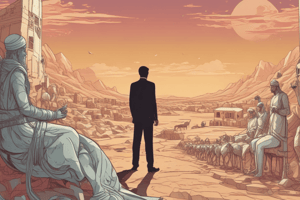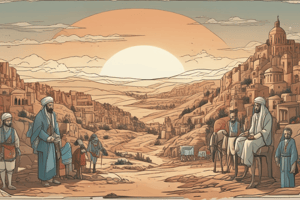Podcast
Questions and Answers
What is the term used in Arabic to refer to the event of Palestinian displacement in 1948?
What is the term used in Arabic to refer to the event of Palestinian displacement in 1948?
- Nakba (correct)
- Hamas
- Intifada
- Oslo
Which territories were captured by Israel during the conflicts of 1956, 1967, and 1973?
Which territories were captured by Israel during the conflicts of 1956, 1967, and 1973?
- West Bank, Gaza Strip, and East Jerusalem (correct)
- Golan Heights, Iran, and Iraq
- Sinai Peninsula, Lebanon, and Jordan
- Egypt, Syria, and Saudi Arabia
What has been a major hindrance to establishing a viable Palestinian state according to the text?
What has been a major hindrance to establishing a viable Palestinian state according to the text?
- Construction of Israeli settlements in occupied territories (correct)
- Palestinian Authority leadership
- Religious diversity in the area
- Lack of natural resources in the region
Which city is a source of contention due to its religious and historical significance in the Israeli-Palestinian conflict?
Which city is a source of contention due to its religious and historical significance in the Israeli-Palestinian conflict?
What is a notable feature of the current political landscape in relation to Palestinians according to the text?
What is a notable feature of the current political landscape in relation to Palestinians according to the text?
Which international organization has played a significant role in addressing the Israeli-Palestinian conflict according to the text?
Which international organization has played a significant role in addressing the Israeli-Palestinian conflict according to the text?
What event contributed to the increased immigration and tensions between European Jews and the native Palestinian population in the region?
What event contributed to the increased immigration and tensions between European Jews and the native Palestinian population in the region?
Which conflict was a result of both sides rejecting the UN General Assembly's plan to partition the area into separate Jewish and Arab states?
Which conflict was a result of both sides rejecting the UN General Assembly's plan to partition the area into separate Jewish and Arab states?
What historical event resulted in hundreds of thousands of Palestinians being displaced from their lands?
What historical event resulted in hundreds of thousands of Palestinians being displaced from their lands?
What was promised in the Balfour Declaration that triggered local Arab opposition?
What was promised in the Balfour Declaration that triggered local Arab opposition?
Which significant event led to European Jews seeking refuge in the region, further escalating tensions with the native Palestinian population?
Which significant event led to European Jews seeking refuge in the region, further escalating tensions with the native Palestinian population?
What role did Resolution 181(II) play in the Israeli-Palestinian conflict?
What role did Resolution 181(II) play in the Israeli-Palestinian conflict?
Flashcards are hidden until you start studying
Study Notes
Conflict between Israel and Palestine
The conflict between Israel and Palestine is one of the most enduring disputes in Middle Eastern politics, with roots dating back more than a century. The struggle centers around the territory that was once part of Mandatory Palestine, which came under British rule after World War I. Over time, the conflict has evolved into a complex web of issues related to self-determination, ethnicity, religion, and nationhood. In this article, we will explore the historical context, current state of affairs, underlying causes, attempts at peacemaking, and the effects on civilians involved in the ongoing confrontation.
History of the Conflict
Origins
The seeds of the Israeli-Palestinian conflict were sown as early as 1917 when Britain's Balfour Declaration promised support for a Jewish homeland in Palestine, despite local Arab opposition. After World War II, European Jews fleeing persecution sought refuge in the region, leading to increased immigration and tensions with the native Palestinian population. In response, the UN General Assembly passed Resolution 181(II) in 1947, partitioning the area into separate Jewish and Arab states. However, both sides rejected the plan, ultimately leading to the 1948 Arab-Israeli War.
Post-Independence
After the establishment of the State of Israel, hundreds of thousands of Palestinians fled their homes during the ensuing war and were displaced from their lands. This event became known as the Nakba or catastrophe in Arabic, and it set the stage for decades of intermittent fighting, marked by wars in 1956, 1967, and 1973. During these conflicts, Israel captured key territories in what is now called the West Bank, Gaza Strip, and East Jerusalem, territories the Palestinians claim and seek as a future state.
Current Situation
Political Landscape
Israel remains a vibrant democracy with a diverse population, while Palestinians are fragmented between territories under Israeli control and those ruled by Hamas in Gaza and Mahmoud Abbas' Palestinian Authority in the West Bank. Despite several peace initiatives, such as the Oslo Accords in 1993 and the Camp David summit in 2000, no comprehensive resolution has been reached. Prospects for a two-state solution have deteriorated due to the expansion of Israeli settlements and continued building in East Jerusalem.
Humanitarian Crisis
The Israeli-Palestinian conflict has resulted in significant human suffering. Palestinians in the Gaza Strip, in particular, face a severe humanitarian crisis, with limited access to clean water, electricity, and healthcare. Meanwhile, about 2 million Palestinians reside in refugee camps in neighboring countries.
Root Causes
Land and Settlements
The quest for territory is a central issue in the conflict. Israel's presence in the West Bank and East Jerusalem has been described as an occupation by Palestinians, who claim these territories as part of their future state. The construction of Israeli settlements in the occupied territories has been a major point of contention, as these settlements are considered illegal under international law and impede the establishment of a viable Palestinian state.
Religious and Ethnic Tensions
Religious and ethnic tensions also play a role in the conflict. The region is home to three main monotheistic religions: Judaism, Christianity, and Islam. The historical and religious significance of Jerusalem and the surrounding areas is a source of contention, as well as the status of Jerusalem as a capital city for both Israel and Palestine.
International Efforts for Peace
UN Resolutions and Peace Processes
The UN has played a significant role in addressing the Israeli-Palestinian conflict, with several resolutions detailing the rights of both parties. The organization has also sponsored peace processes, including the aforementioned Oslo Accords and Camp David summit, which aimed to establish a two-state solution to the conflict.
International Community
The international community has been divided in its approach to the conflict, with some countries recognizing Israel's right to exist as a Jewish state and others supporting a Palestinian state with Jerusalem as its capital. The European Union, for example, has indirectly recognized the Palestinian state through its funding of Palestinian institutions.
Impact on Civilians
Human Rights Violations
The Israeli-Palestinian conflict has led to numerous human rights violations, including the displacement of Palestinians in 1948, ongoing restrictions on their movement, and frequent military operations against Palestinian militants. Israel has also faced criticism for its military actions, particularly during operations in Gaza.
Psychological Trauma
The conflict has taken a heavy toll on civilians psychologically, with high rates of depression, anxiety, and post-traumatic stress disorder among Palestinians and Israelis alike. Research suggests that children in particular may suffer long-term consequences from exposure to violence and trauma.
In conclusion, the Israeli-Palestinian conflict represents a complex web of issues related to territory, identity, and self-determination. Although numerous attempts have been made to resolve the dispute through international efforts, the situation remains fraught with tension and human suffering. As the struggle continues, understanding the historical context, current state of affairs, underlying causes, and impacts on civilians involved becomes increasingly crucial for fostering peace and resolution.
Studying That Suits You
Use AI to generate personalized quizzes and flashcards to suit your learning preferences.




